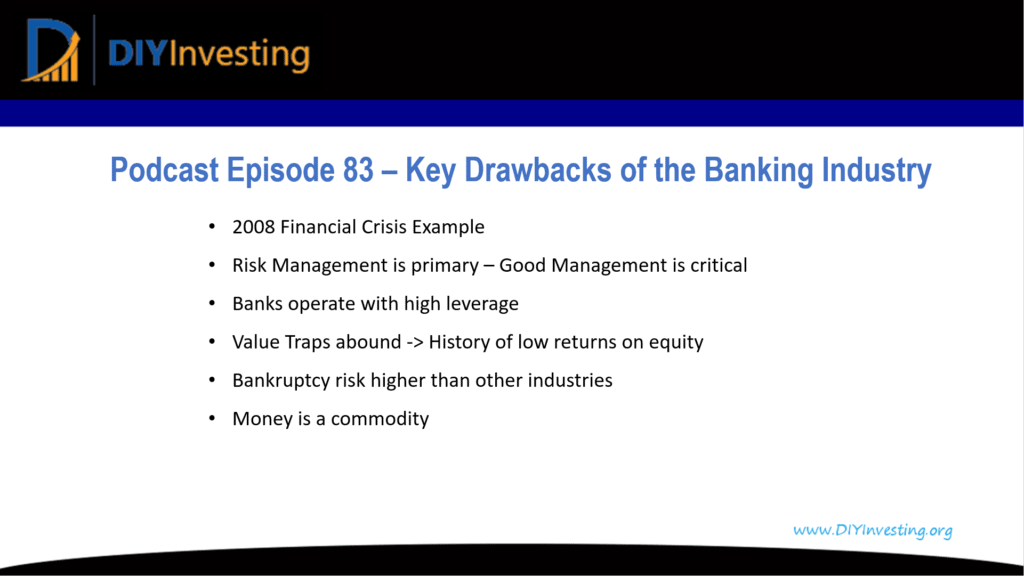Mental Models discussed in this podcast:
- Commodity
- Leverage
- Availability Bias (re 2008 Financial Crisis)
Please review and rate the podcast
If you enjoyed this podcast and found it helpful, please consider leaving me a rating and review. Your feedback helps me to improve the podcast and grow the show’s audience.
Follow me on Twitter and YouTube
Twitter Handle: @TreyHenninger
YouTube Channel: DIY Investing
Support the Podcast on Patreon
This is a podcast supported by listeners like you. If you’d like to support this podcast and help me to continue creating great investing content, please consider becoming a Patron at DIYInvesting.org/Patron.
You can find out more information by listening to episode 11 of this podcast.
Show Outline

Key Characteristics of the banking industry which make it unattractive for investors
- 2008 Financial Crisis
- I could probably end this episode with that statement alone. However, there is value in expanding on what bank investors can learn from the 2008 financial crisis. Specifically, how that event may be repeated or rhyme in the future and how to avoid owning a bank that may be affected.
- Risk Management is primary – which is heavily influenced by management
- A poor management team can quickly ruin a good bank. This is a problem for investors because it requires evaluating management and understanding their ability and focus on managing risk.
- This is harder to do than you may expect because nearly all bank managers are going to pay at least lip service to risk management.
- Buffett once talked about wanting to own a business that could be run by an idiot because eventually, an idiot would run it. Unfortunately, this does not often apply to banks. Why? It will be more clear as we discuss further issues.
- Banks operate with high leverage
- In many industries, high leverage can be seen as a sign of risky decision making. With banking, leverage is a feature. High leverage is not only present across the board in the banking industry but is required in order to earn an adequate return. I covered why in episode 79 when we discussed the banking business model.
- The more leverage a company uses the higher risk of blowing up or bankruptcy due to deteriorating loan performance. This is why management plans such a big role. It is easy to grow a bank by offering loans to people and companies that are not creditworthy. However, doing so sets up failure down the road.
- Leverage = Double-edged sword. Required for adequate returns, but the potential source of bankruptcy. 2008 was a prime example of how this could occur.
- Value Traps abound -> History of low returns, especially among small banks
- While high returning banks that are able to reinvest capital into growth offer great opportunities, there are many more banks that could be a value trap.
- Small community banks often trade below book value which can appeal to value investors. Yet, you’ll find thousands of banks like this which may have returns on equity below 10%. Any growth that these banks experience will lower an investor’s return instead of improving it.
- Time is not on your side if you select the wrong bank because they often don’t earn a high enough return.
- Why? Small towns especially have limited capital available to be stored in a bank. These towns are also heavily hit hard by the move towards online retail, urbanization, and loss of manufacturing jobs.
- Bankruptcy risk is higher than a normal industry
- While all companies can fail due to leverage, banks have more leverage than normal.
- While all companies can fail due to a liquidity trap, a bank’s entire business model is based on lending long-term and borrowing short-term.
- Remember, in episode 82, I talked about the benefit of fewer banks in the industry over time. That only exists because banks continue to fail and/or be bought out by larger competitors. This exemplifies that failure IS an option for many banks and requires a prudent investor.
- Money is a commodity and banks don’t control its price.
- The Federal Reserve in the United States makes a common practice of manipulating the value and price of money. They determine what short-term interest rate should be. There may come a day when that is no longer true, but for now, at least, banks operate in a manipulated market.
- This means that in general, banks don’t have pricing power. The most cost-efficient banks will win, prosper, and grow. Everyone else will fail or shrink away into obscurity.
- The profitability of your common bank will be quite different in different interest rate environments. The shape of the yield curve is critical, but any bank you invest in doesn’t control the yield curve.
Summary:
I want to end this episode with a question. It pertains to both my last episode on the attractive qualities and this one on the unattractive. Which of these two sets of information was most new to you? My guess is that my average listener will be more familiar with the downsides of the banking industry. The 2008 financial crisis is fresh in everyone’s minds. We understand what can happen when banks fail. It is harder to see the massive deals available in the banking industry when a recent crisis is so prominent.
Either way, I hope this information is useful and challenges you to think deeply about the industries you invest in. Don’t simply focus on the attractive qualities. Also, understand what makes an industry unattractive.
Banking is an industry with many key drawbacks including dependence on management for risk reduction, high leverage, low returns on equity, bankruptcy risk, and lack of pricing power because money is a commodity.
